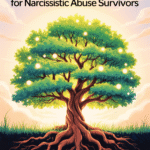Now Reading: What is a Narcissist?
- 01
What is a Narcissist?

- Home
- Narcissism Psychology
- What is a Narcissist?
What is a Narcissist?
Understanding the Mind of a Manipulator
If you’ve ever dealt with someone who twists reality, craves attention, and lacks empathy, you’ve likely encountered a narcissist. But what does that really mean? And how can you protect yourself from their manipulation?
This look into narcissistic personality disorder (NPD) will break down their behaviors, the damage they cause, and most importantly—how to escape their toxic grip using the IMC Method™ (Identify, Minimize, Control).
🔍 The True Definition of a Narcissist: Beyond Surface Level
A narcissist isn’t just someone who’s full of themselves. Clinically, narcissism falls on a spectrum, from mild self-importance to full-blown Narcissistic Personality Disorder (NPD)—a diagnosable condition.
According to the DSM-5 (Diagnostic and Statistical Manual of Mental Disorders), a narcissist displays:
- ✅ A grandiose sense of self-importance (They believe they’re superior)
- ✅ A need for excessive admiration (They thrive on attention)
- ✅ Lack of empathy (They don’t care about your feelings)
- ✅ Exploitative behavior (They use people for their own gain)
- ✅ Entitlement (They believe they deserve special treatment)
- ✅ Arrogance (They look down on others)
Sound familiar? That’s because narcissists show up everywhere—in relationships, families, friendships, workplaces, and even in positions of power.
Deepening the Understanding: The Core of Narcissistic Psychology
To enhance our understanding and build EEAT (Experience, Expertise, Authoritativeness, Trustworthiness), we must delve into the psychological underpinnings of NPD.
- The Fragile Ego: At the heart of narcissism lies a deeply fragile ego. This vulnerability is often masked by an outward display of confidence and arrogance.
- Defense Mechanisms: Narcissistic behaviors are fundamentally defense mechanisms. They serve to protect the individual from perceived threats to their self-esteem.
- Emotional Regulation Deficits: Narcissists struggle with emotional regulation, leading to intense reactions to perceived slights or criticism.
- Interpersonal Dynamics: Their relationships are characterized by power imbalances and a lack of genuine connection. They often view others as extensions of themselves.
- The Cycle of Narcissistic Supply: Narcissists require a constant stream of validation and admiration, known as “narcissistic supply,” to maintain their sense of self-worth.
- Comorbidity: It is important to note that NPD can occur along side other mental health conditions, like anxiety, depression, and antisocial personality disorder.
🔥 The 3 Types of Narcissists (And How They Operate):
Not all narcissists are loud and obvious. Some hide in plain sight. Here’s how to spot them:
1️⃣ Grandiose Narcissists (The Classic Manipulator): The Overt Display
- These individuals openly exhibit their superiority and crave constant praise.
- They often dominate conversations, boast about their achievements, and belittle others.
- They are masters of manipulation, using charm and charisma to get what they want.
- They have little to no tolerance for criticism.
- They often display extreme entitlement.
🔹 Example: Your boss who steals credit for your work and makes you feel worthless, while publicly taking all the praise.
2️⃣ Covert Narcissists (The Silent Saboteurs): The Hidden Agenda
- Unlike the grandiose type, covert narcissists are more subtle in their manipulation.
- They often play the victim, using guilt, passive-aggressiveness, and silent treatments to control others.
- They are highly sensitive to criticism and often harbor deep resentment.
- They will use backhanded compliments, and “joking” insults.
- They are masters of gaining sympathy, and using it as a weapon.
🔹 Example: A friend who always claims to be the real victim, even when they’re the ones causing harm, and who makes you feel guilty for any perceived slight.
3️⃣ Malignant Narcissists (The Dangerous Ones): The Toxic Core
- This is the most toxic and dangerous type of narcissist.
- They exhibit sociopathic tendencies, including lying, cheating, manipulation, and a lack of remorse.
- They enjoy inflicting pain, and causing chaos.
- They often use intimidation, and threats.
- They will destroy the lives of those around them.
🔹 Example: An abusive partner who gaslights you, destroys your self-worth, keeps you trapped, and enjoys your pain.
4️⃣ Communal Narcissists (The Benevolent Facade): The Moral Superiority
* They gain narcissistic supply by appearing to be extremely helpful, and moral.
* They use charitable acts as a way to manipulate others.
* They will attack anyone who questions their moral standing.
* They will use their “good deeds” as a way to control others.
🚨 How Narcissists Destroy Lives (And Why You Must Protect Yourself): The Devastating Impact
Narcissists are emotional parasites. They:
- ❌ Gaslight You: They make you question your reality, leading to confusion and self-doubt.
- ❌ Love Bomb & Discard: They shower you with love and affection, then abruptly withdraw it, creating a cycle of hope and despair.
- ❌ Use Flying Monkeys: They enlist others to do their dirty work, turning them against you and isolating you from support.
- ❌ Exploit You: They drain you emotionally, financially, and mentally, leaving you feeling depleted and worthless.
- ❌ Cause Trauma Bonding: They create a cycle of abuse that makes it difficult to leave.
- ❌ Induce Cognitive Dissonance: They create mental conflict by contradicting their words and actions.
- ❌ Use Projection: They blame you for their own negative behaviors.
- ❌ Smear Campaign: They spread lies and rumors to ruin your reputation.
The longer you stay, the harder it is to escape. But you CAN break free.
🧠 The Science Behind Narcissism: What’s Happening in Their Brain?
Understanding narcissists on a deeper level means looking beyond their behavior and into their neurology. Research in neuroscience and psychology reveals that narcissists’ brains are wired differently—making them more prone to manipulation, entitlement, and lack of empathy.
🔬 Key Brain Differences in Narcissists:
1️⃣ Lower Gray Matter in the Anterior Insula (The Empathy Center)
- The anterior insula is responsible for empathy and emotional regulation.
- Studies show narcissists have reduced gray matter in this region, which explains their lack of concern for others’ feelings.
- This is why they can watch you suffer and feel nothing—or even enjoy it.
2️⃣ Overactive Reward System (Dopamine Dysfunction)
- Narcissists have an exaggerated response to praise, admiration, and status.
- Their dopamine system is hypersensitive, making them addicted to validation and control.
- This is why they need a constant supply of narcissistic fuel (attention, admiration, drama).
3️⃣ Impaired Prefrontal Cortex Function (Lack of Impulse Control & Self-Reflection)
- The prefrontal cortex controls decision-making, impulse regulation, and self-awareness.
- Narcissists show reduced activity in this area, meaning they act impulsively, lash out, and rarely reflect on their actions.
- This is why they refuse to take accountability and repeat the same toxic cycles.
4️⃣ Stronger Amygdala Reactions (Extreme Sensitivity to Criticism)
- The amygdala is the brain’s emotional threat detector.
- In narcissists, this area overreacts to perceived insults or rejection, triggering rage, manipulation, or silent treatment.
- This explains why narcissists can explode over the smallest slight but feel nothing when they hurt others.
🛑 Why This Matters for You
Narcissists don’t just choose to be the way they are—their brains are wired for manipulation, control, and self-preservation at your expense.
❌ You will never get empathy from them—they don’t have the brain structures for it.
❌ They will never change—because they lack self-awareness and impulse control.
❌ They will always seek validation—because their dopamine system is broken.
🔹 The Takeaway: The best strategy isn’t to change them—it’s to protect yourself using the IMC Method™.
🚀 Break Free. Reclaim Your Power. The Science is on Your Side. 🔥
🛡️ How to Stop a Narcissist: The IMC Method™
The IMC Method™ (Identify, Minimize, Control) is a proven strategy for dealing with narcissists. Here’s how to use it with greater depth:
✅ Step 1: Identify the Narcissist: Recognizing the Patterns
- Recognize the red flags early:
- Do they lack empathy and consistently disregard your feelings?
- Do they manipulate and lie to get what they want?
- Are they always the victim, even when they’re the perpetrator?
- Do they display excessive need for admiration?
- Do they display extreme entitlement?
- Do they use triangulation?
- Educate yourself on narcissistic tactics, such as gaslighting, triangulation, and projection.
- Document every interaction, to prove to yourself, and others what is happening.
The moment you identify a narcissist, you gain the power to protect yourself.
✅ Step 2: Minimize Contact: Creating Distance
- 🚫 Gray Rock Method – Become uninteresting to them: Respond with brief, neutral answers, and avoid engaging in emotional conversations.
- 🚫 Low Contact – If you can’t go No Contact, reduce interactions: Limit communication to essential matters and avoid sharing personal information.
- 🚫 Emotional Detachment – Stop reacting to their mind games: Practice mindfulness and emotional regulation to avoid being drawn into their drama.
- Create and enforce strict boundaries.
- Block them on social media.
✅ Step 3: Control Your Narrative: Reclaiming Your Power
- 🎯 Block their manipulation – Set firm boundaries: Establish clear limits and enforce them consistently.
- 🎯 Expose their tactics – Call out their gaslighting with facts: Challenge their distorted reality with evidence and logic.
- 🎯 Reclaim your power – Start healing and building your new life: Focus on self-care, therapy, and building a supportive network.
- Focus on rebuilding your self esteem.
- Learn to trust your own judgement.
- Seek therapy from a trauma informed therapist.
🔥 No one deserves to live under a narcissist’s control. It’s time to break free and take back your life.
📖 Ready to Take the Next Step? Further Resources and Support
- Seek professional therapy from a therapist experienced in narcissistic abuse.
- Join support groups for survivors of narcissistic abuse.
- Read books and articles on NPD and narcissistic abuse.
- Practice self-compassion and be patient with your healing process.
🚀 Ready to Take Back Control? Start Now!
📖 Read Love Bombing: The Basics – The first step in breaking free from manipulation. Learn how narcissists use love bombing to trap their victims—and how to break the cycle.
🔗 Get it now on Kindle Unlimited or grab your copy today!
✨ The Proven IMC Method™ – Abuse No More Exclusive
🚀 Backed by 20+ years of research and investigative experience.
🔎 Built on the same psychological warfare techniques used by top government agencies—so you can see manipulation before it even starts.
🛡 The IMC Method™ is designed to expose, dismantle, and neutralize narcissistic manipulation—so you can break free, reclaim your power, and protect yourself with confidence.
7 Frequently Asked Questions About the “What is a Narcissist?” Article
1️⃣ Is narcissism just being self-centered or arrogant?
No! While all narcissists are self-centered, not all self-centered people are narcissists. True narcissism involves manipulation, lack of empathy, and a deep need for control. It’s not just about confidence—it’s about using others for personal gain.
2️⃣ Can narcissists change?
Rarely. Narcissists don’t see themselves as the problem, so they resist therapy, deny accountability, and continue their toxic behaviors. Change is possible—but only for those willing to put in the work (which narcissists typically aren’t).
3️⃣ What’s the difference between a narcissist and a sociopath?
While both lack empathy, narcissists crave admiration, whereas sociopaths crave power and control. Malignant narcissists can have traits of both, making them especially dangerous.
4️⃣ How do I know if I’m dealing with a narcissist?
Look for key signs like love bombing, gaslighting, lack of accountability, and manipulation. If someone constantly makes you doubt yourself, plays the victim, or exploits you, trust your gut—it’s not normal.
5️⃣ Can I have a healthy relationship with a narcissist?
No. Narcissists thrive on control and emotional chaos. A relationship with one will always be one-sided, exhausting, and damaging.
6️⃣ How do I protect myself from narcissists?
✅ Learn to recognize their tactics
✅ Set strong, non-negotiable boundaries
✅ Stop justifying or excusing toxic behavior
✅ Use the IMC Method™ (Identify, Minimize, Control) to break free
7️⃣ What should I do if I think I’m being manipulated?
🚨 Get educated—understanding narcissistic behavior is your first defense.
🚨 Create distance—emotionally detach and minimize interaction.
🚨 Seek support—from a therapist, support group, or trusted friends.
🚨 Take action—the longer you stay, the harder it is to leave.
💡 Want to go deeper? Read Love Bombing: The Basics and start protecting yourself today!
🔗
7 Links That Back You Up Like a Truth Sledgehammer
1️⃣
Mayo Clinic – Narcissistic Personality Disorder (NPD)
Want receipts? Here’s the clinical breakdown. The Mayo Clinic lays out exactly what narcissistic personality disorder looks like—from the chronic grandiosity to the cold-blooded lack of empathy. This isn’t your ex just being “difficult.” It’s a pattern of psychological abuse with a diagnostic label. Print it. Screenshot it. Shove it in the gaslighter’s denial spiral.
2️⃣
National Library of Medicine – Neurobiology of Narcissism
You don’t just feel like something’s wrong — their brain literally fires differently. This peer-reviewed study shows how narcissists are hardwired to crave control, attention, and admiration like oxygen, while the part of their brain responsible for empathy? Yeah, that’s underdeveloped. So no, they’re not “just stressed.” They’re neurologically built for manipulation.
3️⃣
American Psychological Association – Narcissism: A Clinical Look
Still doubting yourself? Here’s the APA’s breakdown — the same organization that trains therapists and writes the books they study. It confirms that narcissists aren’t “confused” or “insecure”—they’re controlling, self-obsessed, and emotionally exploitative by design. And the kicker? They know exactly what they’re doing.
4️⃣
Verywell Mind – What Is Malignant Narcissism?
Malignant narcissists don’t just manipulate — they destroy. This article breaks down the worst of the worst: those who lie, cheat, gaslight, and enjoy your pain. These aren’t your garden-variety jerks. These are predators who treat people like prey, and the longer you stay, the more they eat.
5️⃣
Psychology Today – What Is Narcissistic Supply?
Narcissists don’t love you. They use you. And what they’re after is narcissistic supply — your attention, your reactions, your chaos. This article explains the cycle they live on and why cutting off their fuel is the most powerful thing you can do. Starve the ego. Watch the monster panic.
6️⃣
Cleveland Clinic – Signs of Narcissistic Abuse
Still wondering if it’s “really abuse”? The Cleveland Clinic doesn’t mince words. Narcissistic abuse leads to anxiety, depression, CPTSD, and identity collapse. If you’re constantly walking on eggshells, doubting your memory, and feeling like you’ve disappeared—this article confirms it’s not in your head. It’s in your nervous system.
7️⃣
PubMed – NPD and Mental Health Comorbidities
Narcissists don’t operate in isolation—they bring baggage. Research confirms that narcissists often have co-occurring disorders like depression, antisocial traits, or anxiety. Translation? They’re not just difficult people. They’re volatile systems. And the deeper you’re in, the more you get pulled into their storm.
🔁
3 Abuse No More Links That Keep Survivors Locked In and Leveling Up
🔹
Love Bombing: The Basics
Remember how perfect they seemed at the beginning? That wasn’t love — that was bait. Love bombing is how narcissists hook you fast and hard. This article breaks it all down: the flowers, the intensity, the “you’re my soulmate” BS — and how it all turns to punishment the second you stop playing along.
🔹
Gaslighting: The Ultimate Mind Game
“That never happened.” “You’re being too sensitive.” “You’re crazy.” Sound familiar? Gaslighting is psychological warfare — and they use it to make you question your memory, your emotions, and your reality. This guide doesn’t just call it out. It gives you the tools to break the spell and take your mind back.
🔹
The IMC Method™ – Your Strategic Exit Plan
You don’t beat narcissists by yelling louder. You beat them by seeing their game, cutting the fuel, and controlling your narrative. That’s what the IMC Method™ (Identify, Minimize, Control) does — and this link walks you through it step-by-step. Just strategy.
















